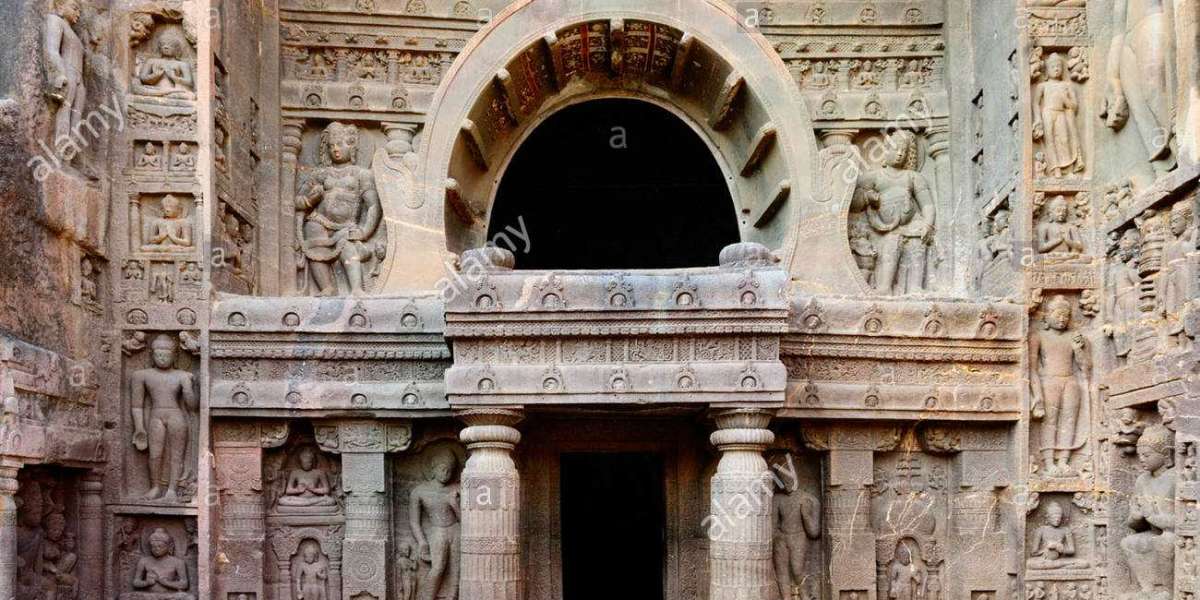The political strength of the Guptas and the cultural florescence that they apparently fostered are often compared to aspects of the Maurya Dynasty, and, indeed, it has been suggested that the Guptas consciously looked back to the Maurya period for a model upon which to base their own empire.
An unusual, larger than life-size stone sculpture of a horse (found at Khairigarh in UP) has been said to represent a sacrificial horse used by Samudragupta for one of the asvamedha rituals performed, an event also commemorated in his asvamedha coin type.
Three Jain-images found at Durjanpura are critical of the early Gupta art. The best preserved shows a central figure sitting in vajraparyankasana with his hands in dhyana mudra attended by two cauri bearers. A halo comprised of a scalloped flame motif around the perimeter reminiscent of Kushana formulations of Mathura school and containing an open lotus blossom, appears behind his head. In all, the configuration is similar to that of Buddhist and Jaina images of the Kushana period. A movement toward what is considered the Gupta ideal is suggested in the ornamentation of the halo.
HINDU ART DURING EARLY GUPTA PERIOD: Udaygiri, rock-cut chambers two of which bears inscriptions from the reign of Chandragupta II; vital documents of Hindu-art. The off-centre doorway having representations of two goddesses standing atop makaras above. These figures are precursors to the depictions of the river goddesses Ganga and Yamuna, who stand atop the makara and tortoise respectively.
Stylistic progression in the sculptures of the door guardians (dvarapalas). In spite of the muscular physiques reminiscent of Kusana precedents, the figures show a new smoothness to the forms of their bodies, foreshadowing the more graceful depictions. The elaborate coiffures are also characteristic of developed Gupta forms, emphasizing delicate locks of hair arranged in luxuriant profusion atop the head.
UDAYGIRI CAVES
Cave-5:This cave have walls depicting different deities and perhaps constitute the earliest example of a unified iconographic program in Hindu art. Ganesa, Mahishamardini, Visnu etc.
As the “Overcomer of Obstacles” Ganesa is invariably invoked at the beginning of the worship to help the devotee seeks release. Durga’s defeat of the asura, buffalo form, might indicate the victory over samsara and the defeat of the death, that is, achievement of the immortality. The Udaygiri image shows Durga in a twelve-armed form, indicative of the trend toward increased use of multiple body parts in representations of divinities during this period. Her emergence as the supreme goddess perhaps a continuity with the prehistoric emphasis on the female.
This cave is also evident of the emerging incarnation cults of Vishnu and depicts them in human forms in heroic scenes. -Varaha;
Cave-4: A one-faced linga (ekamukhalinga) is the main object of worship in Cave 4 at Udaygiri (Saivite cave). The round face with rather heavy features is reminiscent of Kushana types.
An approximately human-size representation of the god Hari-Hara, a syncretic union of Siva and Vishnu (early 5th c, MP) resembles with Udaygiri sculptures. Not only are the two halves of the headdress differentiated but presumably the attributes originally held in the hands would have been appropriate to each of the deities. Such an image indicates not only a well-developed iconography for each of the gods, but a stage of religious development in which both had been reconciled into a syncretic statement- that of ultimately unity in spite of apparent duality.
Krsna, best known later as the 9th incarnation of Vishnu, also appears in sculptures from the early 5th c- Varanasi, as Krsna Govardhanadhara, or Bearer of Govardhana. Krsna’s name (the Black One) is probable reference to his Dravidian origin. His role as cowherd and protector of the pastoral people suggests further affinities to the cow-worshiping people of pre-Vedic Indic society. His emergence during the Gupta period as a popular god reflects the resurfacing of an ancient concept rather than an innovation. Influence of Vaishnavism can be seen in the Eran region (a Vaishnavite site) , with huge sculptures and portraits of different incarnations of Vishnu being carved.
BUDDHIST ART OF THE FIFTH CENTURY: NORTH-CENTRAL INDIA (SANCI)
Patronage was also given to the Buddhist community, in the construction of their monuments, by the Gupta rulers. An inscription added to the eastern torana of the Great Stupa at Sanci refers to Chandragupta II and the year 93 and records a grant in favor of Buddhist community by an individual who was apparently an officer of Chandragupta II. The renewed effort at Sanci during the 5th c. involved both the creation of new monuments and the refurbishing of old. The new burst in part might have been due to renewed imperial power and wealth in the region. More typical Mahayana forms were visible in this renewed efforts. A pillar crowned by a representation of the Bodhisattvas Vajrapani was set up near the northern gateway of the ancient stupa. An interesting feature of this sculpture is the halo behind the head with its twelve evenly spaced holes piercing the ruin.
One of the most important as well as perfectly preserved of the Gupta-period structures at Sanci is the small shrine known as Temple 17. Its small size, unpretentious form, and simplicity are characteristic of early Gupta-period architecture. Although this temple appears to be solidly built, several features imply that the craft of building in stone was still in its infant stage; the structure totally lacks foundations, which resulted in buckling of the walls and partial collapse of the roof.
Stone structures without the rubble core came to be used in Indie architecture. Sculptural ornamentation is confined to the doorway and to the pillars. Certain features of the pillars, such as the ad- dorsed reclining lions, which form the decoration of the capitals, and the lotus bells recall Maurya-period precedents. It generally enough to relate to both Buddhist and Hindu monuments.
BUDDHIST ART OF THE 5TH CENTURY: NORTH INDIA (MATHURA AND SARNATH)
When Samudra- gupta defeated the Nagas, the Mathura region was incorporated into the Gupta domain. The heritage of Kusana art of both the Mathura and the Bactro-Gandhara regions remains visible in the Mathura Gupta style. On the basis of its strong similarities to a recently discovered Buddha sculpture from Mathura dated to a.d. 434,19 a standing Buddha image from Mathura may be used to define the Mathura Gupta style of about the mid-fifth century (Fig. 10.18). An inscription on the pedestal states that the image was dedicated by a monk named Yasadinna
Compared with Kusana-period sculptures of the Mathura style, the contours of the body are more fluid and graceful and the body is slenderer.
The halo, reveal that a Gupta-period aesthetic had developed and unified the art at distant Buddhist sites like Sanci and Mathura. Such folds were absent from the typical drapery of Kusana- period Mathura sculptures. The Gupta- period artists of Mathura seem to have unified the two traditions into a harmonious synthesis, reconciling the classicist style of the northwest, emphasizing garment depiction, with the Indie love of the human form.
All figures subsidiary to the main Buddha in each sculpture are depicted in hierarchical scale, such scaling pervades the art of South Asia, and is characteristic of most Buddhist, Hindu and Jain artistic conceptions. By the Gupta time, variations in dharmacakra mudra became by far the most common indicators of the event and of Buddhist teachings in general.
A particularly fine example of the Sarnath treatment of the bodhisattva shows Khasarpana Avalokitesvara standing in the slightly relaxed abhanga pose; adorned with jewellery and has a smiling face; half-closed eyes suggests an inner calm that makes the Gupta idiom at Sarnath one of the most appealing of the Indic art styles.
Stucco became a major artistic medium for making sculptures, besides stone, by the 2nd and 3rd centuries. Perhaps the inexpensiveness of this material accounts for its popularity. At Hadda, in Afghanistan clear evidence of the Bactro-Gandhara heritage is seen in the depiction of the Buddha’s robe, his hair style and even in their faces; suggesting that the Gupta style had permeated the perimeters of the empire. At Mirpur Khas in Sind (stupa), seated Buddha betray a blending of northwest Kusana and Gupta idioms. Bamiyan, Afghanistan; creation of such enormous images is associated with the cult of the Brhad (gigantic) Buddha which is prevalent in South Asia as well as in other regions that were influenced by Indian Mahayana Buddhism. The clinging appearance of the garment, which reveals the form of the Buddhas’s body beneath, suggests ties to Gupta art in India proper.
HINDU TEMPLE ARCHITECTURE
Usually, these structures are classified according to certain physical characteristics as well as their relationship to later forms. Some of the forms reflect structures that must have existed prior to the fifth century but which have been lost, and others may have been completely innovative.
Developed forms: Sanci Temple 17- serves as an example of one characteristic type of Gupta temple. By the end of the 5th century or the beginning of the sixth, a type of temple with a tower (shikhara) was well developed. One such example is Vishnu Temple at Deograh commonly called Dasavatara because it was originally thought that the iconographic program referred to the ten incarnations of Vishnu. Structure may be dated to 6th century; apparently curvilinear shape anticipates the developed northern-style shikhara. The temple is of the panchayatana (five-shrine) variety. Each shrine was probably dedicated to a different Hindu deity. In contrast to the early Gupta-type entrance seen at Udaygiri, the Deogarh doorway is a greatly elaborated ensemble. Foliate motifs, mithunas, guardian figures and river goddesses with their vehicles. Vishnu depicted in two other forms other than its real form; Narsimha and Vamana. The multiple figures in this small relief demonstrate the growing complexity of Vaishnavite iconography, and perhaps provide a clue to the original dedication of the temple. The practice of circumambulation around the temple let us view the three great sculptures on the body of the temple. Reliefs of Vishnu Narayana as Anantasayana; Nara and Narayana- who bring the message of divine love; and Gajendra Moksha-story of a king who had been changed into elephant by a curse. The circumambulation of this temple is anti-clockwise contrary to the commonly held clockwise circumambulation in the Hindu worship; is based on internal message of the relief.
Ganesa on the south indicates that the devotee started its worship in that direction.
Parvati temple at Nachna Kuthara- is a notable achievement of Gupta art and was originally dedicated to Shiva. Its form offers insight into a completely different temple format in use at the time. Double-storied structure resting on a plinth with an enclosed circumambulatory passage and thus is the oldest known temple of the sandhara class of the Hindu temples. Perhaps specific ritual needs necessitated the double-storied form. Doorway and the three latise windows around the temple testify to a high quality of workmanship.
BRICK TEMPLES AND TERRACOTTA ART
During the Gupta period, interest in brick and terracotta led to the construction of a number of important monuments some of which have survived. The brick temple Bhitargaon is the best preserved example. Burnt bricks joined by mud and mortar were used in the construction of the building, and the walls reached a thickness of more than 2 meters.
Terracotta life-size sculptures of the river goddesses and are still preserved. In contrast to the terracotta of the prehistoric period Gupta terracottas are often large. Ahichhattra and Bhitoragaon two of the most well known and well preserved sites that yielded Gupta period terracottas in northern India. The curly hair of Garuda suggests aesthetic associations with stone art of the Gupta period. One of the most dramatic and realistic of all the terra cottas surviving from the Gupta period represents a Saivite deity Saheth-Maheth, Saraswati, UP.
Mahabodhi temple at Bodhgaya, most sacred of the Buddhist shrines; repaired many times.
METAL IMAGES
However, a hoard of metal images found at Chausa, Bihar, contained examples that clearly seem to be of Gupta date. One representation of Rsabhanatha, the Jain tirthahkara, especially reveals the grace of form and naturalism associated with Gupta art.







